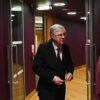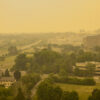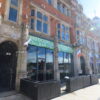Coronavirus News
Coronavirus Coronavirus: What’s happening around the world on Monday
Hospitals rapidly approached capacity across the U.S. Sunbelt, and the Miami area closed restaurants and gyms again, as the country emerged from a holiday weekend that health officials fear could fuel the worsening coronavirus outbreak. Here is what’s going on around the world.A nun with the Saint Ann Mission, who declined to give her name, leaves…

Coronavirus
Hospitals rapidly approached capacity across the U.S. Sunbelt, and the Miami area closed restaurants and gyms again, as the country emerged from a holiday weekend that health officials fear could fuel the worsening coronavirus outbreak. Here is what’s going on around the world.

The latest:
- Miami-Dade County imposes restrictions after cases spike.
- Trump-connected lobbyists reap more than $10B in U.S. federal pandemic aid, report finds.
- Hundreds of scientists say coronavirus is airborne.
- India overtakes Russia to become 3rd worst-affected nation by COVID-19.
- Canadian Broadway actor Nick Cordero, 41, dies from coronavirus complications.
- Philippines reports largest case spike in recent days.
Hospitals rapidly approached capacity across the U.S. Sunbelt, and the Miami area closed restaurants and gyms again on Monday because of the surging coronavirus, as the country emerged from a Fourth of July weekend of picnics, pool parties and beach outings that health officials fear could fuel the rapidly worsening outbreak.
The see-saw effect — restrictions lifted, then reimposed — has been seen around the country in recent weeks and is expected again after a holiday that saw crowds of people celebrating, many without masks.
“We were concerned before the weekend and remain concerned post-holiday, as anecdotal stories and observed behaviour indicate that many continue to disregard important protective guidance,” said Heather Woolwine, a spokesperson for the Medical University of South Carolina.
Confirmed cases are on the rise in 41 out of 50 states plus the District of Columbia, and the percentage of tests coming back positive for the virus is increasing in 39 states.
Florida, which recorded an all-time high of 11,400 cases Saturday and has seen its positive test rate over the past two weeks reach more than 18 per cent, has been especially hard hit, along with other Sunbelt states, such as Arizona, California and Texas.
A virus outbreak in the California legislature indefinitely delayed the state assembly’s return to work from a scheduled summer recess. Five people including Assemblywoman Autumn Burke tested positive. Coronavirus hospitalizations in California have increased 56 per cent in the past two weeks while the number of confirmed cases has jumped 53 per cent.
In Florida’s Miami-Dade County, population 2.7 million, Mayor Carlos Gimenez issued an emergency order closing restaurants and certain other indoor places, seven weeks after they were allowed to reopen. Beaches will reopen in the county on Tuesday after being closed over the weekend.
“But if we see crowding and people not following the public health rules, I will be forced to close the beaches again,” the mayor warned.
Officials in Texas said hospitals are in danger of being overwhelmed. Hospitalizations statewide surged past 8,000 for the first time over the Fourth of July weekend, a more than fourfold increase in the past month.
Houston officials said intensive care units there have exceeded capacity.
WATCH | Epidemiologist on COVID-19’s rapid global rise, the Atlantic bubble and beach shaming:
Dr. Christopher Labos says the coronavirus is still circulating even when numbers appear very low and public health measures must still be followed to keep it under control. 8:18
Along the border with Mexico, two severely ill patients were flown hundreds of kilometres north to Dallas and San Antonio, Texas, because hospitals in the Rio Grande Valley were full.
In Arizona, the number of confirmed cases has surpassed 100,000. State health officials said more than half of those infected, or over 62,000, are under 44.
Around the country, health officials have said the surge is being driven in large part by younger people who are disregarding the physical distancing rules and warned that they could easily spread it to older, more vulnerable people.
The coronavirus is blamed for more than 535,000 deaths worldwide, including more than 130,000 in the U.S., according to the tally kept by Johns Hopkins University. The number of confirmed cases in the U.S. stood at about 2.9 million, though the real number of infections is believed to be 10 times higher.

Meanwhile, Atlanta Mayor Keisha Lance Bottoms announced Monday that she had tested positive for the virus.
“COVID-19 has literally hit home. I have had NO symptoms and have tested positive,” tweeted Bottoms, a potential Democratic vice-presidential candidate.
She told MSNBC that she decided her family members should get tested again because her husband “literally has been sleeping since Thursday.”
Bottoms, in her first term as mayor, has risen to prominence during the pandemic. She has been noted for her earlier criticism of Republican Georgia Gov. Brian Kemp on his slowness to order Georgians to shelter in place and his quickness to lift that order.
She was an early and vocal supporter of presumptive Democratic nominee Joe Biden, speaking on his behalf in Iowa before that state’s caucus. The former vice-president has been considering Bottoms as his possible vice-presidential running mate in his own presidential bid.
Bottoms has supported protests against police brutality and racial injustice that have been widespread in Atlanta, urging protesters to get tested for the virus.
Coronavirus What’s happening with COVID-19 in Canada
As of 7:45 p.m. ET on Monday, Canada had 105,935 confirmed and presumptive coronavirus cases. Provinces and territories listed 69,570 of the cases as recovered or resolved. A CBC News tally of deaths based on provincial reports, regional health information and CBC’s reporting stood at 8,738.
Ontario’s courts will resume in-person proceedings Monday after being shuttered for months due to the COVID-19 pandemic.
The Ministry of the Attorney General has said courtrooms will reopen gradually, with the goal of having all courtrooms operational by Nov. 1. Courthouses have been closed since March 16, with some operations moving online.
- 1st glimpse of Canada’s true COVID-19 infection rate expected mid-July from immunity testing
- Companies that laid off workers due to COVID tell Bank of Canada they plan to rehire this year
- N.S. tracing contacts of traveller connected to new COVID-19 cases on P.E.I.
- Halifax man walks off flight to St. John’s over COVID-19 concerns
The initial plan was to have 149 courtrooms in both the Superior Court of Justice and the Ontario Court of Justice open today for trials and preliminary inquiries in 44 locations, but on Saturday, the ministry announced that two of those locations were not yet ready to reopen.
In the courthouses that are reopening, there will be Plexiglas barriers in courtrooms, interview rooms, intake offices and at public counters.
WATCH | New P.E.I. cases remind us risk still present, chief public health officer says:
Though disappointed by 2 new COVID-19 cases on P.E.I., Dr. Heather Morrison says contact tracing tests have all been negative. 8:01
Coronavirus Here’s what’s happening around the world
More than 200 scientists have called for the World Health Organization and others to acknowledge that the coronavirus can spread in the air — a change that could alter some of the current measures being taken to stop the pandemic.
In a letter published this week in the journal Clinical Infectious Diseases, two scientists from Australia and the U.S. wrote that studies have shown “beyond any reasonable doubt that viruses are released during exhalation, talking and coughing in microdroplets small enough to remain aloft in the air.”
That means people in certain indoor conditions could be at greater risk of being infected than was previously thought.
WHO has long maintained that COVID-19 is spread via larger respiratory droplets that fall to the ground, most often when people cough or sneeze.
It has dismissed the possibility of airborne transmission, except for certain high-risk medical procedures, like when patients are first put on breathing machines.
In a statement on Monday, the UN health agency said it was aware of the article and was reviewing it with technical experts.
WATCH | Microscopic droplets explain COVID-19 spread in some situations, professor says:
A signatory of the letter urging the WHO to change its recommendations around COVID-19 airborne transmission says it would be wise to do as much as we can to slow down the virus. 6:00
Brazilian President Jair Bolsonaro says he will be tested for COVID-19 after having an X-ray of his lungs on Monday.
He didn’t say whether he was showing symptoms of the coronavirus.
Bolsonaro, who has repeatedly downplayed the risks of the virus, told supporters outside the presidential residence in capital Brasilia that he is feeling well.
Over the weekend, he attended multiple events and was in close contact with the U.S. ambassador to Brazil during July 4 celebrations. The U.S. Embassy in Brasilia did not immediately respond to a request for comment.
India has overtaken Russia with the world’s third-highest number of coronavirus cases at nearly 700,000, according to the latest data, as the outbreak shows no sign of slowing.
Health Ministry data on Monday showed more than 23,000 new cases reported in the previous 24 hours, down slightly from Sunday’s record increase of almost 25,000.
There have been almost 20,000 deaths in India since the first case was detected there in January.
India is now the world’s third worst-affected country, behind only the U.S. and Brazil.

It has seen eight times the number of cases as China, which has a similar-sized population and where the virus originated late last year.
Officials said they had reversed a decision to reopen the Taj Mahal, India’s most famous tourist attraction, in the city of Agra, 200 kilometres southeast of New Delhi, on Monday, following a spate of new cases in the area.
However, some other monuments in and around the capital New Delhi opened on Monday, albeit with very few visitors. India is pushing ahead with relaxations to its more than two-month lockdown amid grim economic forecasts.
Authorities in Greece say the majority of new cases reported there Monday have come from tourists following a new round of border and airport openings last week.
The Health Ministry said 43 newly confirmed cases were recorded in the latest 24-hour reporting period, 36 of which were detected at tourist entry points.

Tourism is a vital industry for the Greek economy and restrictions for travellers have been eased in recent weeks.
Most tourists are now subjected only to spot checks.
The total number of confirmed cases in Greece stood at 3,562, while the death toll was unchanged at 192.
The Philippines has reported its biggest spike in coronavirus infections in recent days, raising the possibility its crowded capital may be placed back under a strict lockdown.
The Department of Health reported 2,434 cases in recent days, most of them in metropolitan Manila, raising the number of cases nationwide to more than 44,250, including 1,297 deaths. The infections and deaths are among the highest in Southeast Asia.
Interior Secretary Eduardo Ano said there’s a possibility the capital area may revert to a lockdown if the uptick continues and hospitals get filled again.

At least one major Manila hospital, the Chinese General Hospital and Medical Centre, said its COVID-19 ward was running at full capacity and appealed that new patients be taken elsewhere.
The leader of Australia’s most populous state says her government’s decision to close its border with hard-hit Victoria state marks a new phase in the country’s coronavirus pandemic.
New South Wales Premier Gladys Berejiklian had long been a critic of states that closed their borders to her state when its capital Sydney had Australia’s largest numbers of COVID-19 cases.
But she had changed her stance on keeping Australia’s internal borders open because the situation in Melbourne, capital of Victoria, was unprecedented.
The overwhelming majority of new cases detected in Melbourne in recent weeks were from community transmission. Everywhere else in Australia, the vast majority of cases were infected overseas or had been infected by a returned traveller, Berejiklian said.
“What is occurring in Victoria has not yet occurred anywhere else in Australia,” she said. “It’s a new part of the pandemic and, as such, it requires a new type of response.”

Pakistan’s Minister of State for Health Zafar Mirza tested positive for the coronavirus, the latest high-profile government minister to contract the virus.
Foreign Minister Moahmood Qureshi announced Friday that he too tested positive for the virus.
Pakistan has recorded 231,813 infections and 4,762 deaths. Prime Minister Imran Khan has refused to impose strict lockdowns and has eased many restrictions. However, he has ordered people to wear masks and physically distance, though most people, especially the poor and residents in the congested cities, are not able to keep their distance.
Paris‘s Louvre Museum, which houses the Mona Lisa, reopened Monday after a four-month coronavirus lockdown and without its usual huge throngs.

Face masks were a must and visitor numbers were limited, with reservations required. Among the trickle of returning tourists was Zino Vandenbeaghen, who travelled from Belgium to enjoy the unusual space at both the Louvre and the Palace of Versailles.
About 70 per cent of the giant museum — 45,000 square metres of space — housing 30,000 of the Louvre’s vast trove of works is again accessible to visitors starved of art in lockdown.
“It’s very emotional for all the teams that have prepared this reopening,” said Jean-Luc Martinez, the museum director.
The bulk of visitors to what was the world’s most-visited museum before the pandemic used to come from overseas, led by travellers from the United States.
The Louvre is hoping the reopening will attract visitors from closer to home, including the Paris region, but is bracing for a plunge in numbers.
WATCH | Louvre reopens in Paris with strict security precautions during COVID-19:
The museum’s director says the number of visitors is so restricted that some might find themselves in a rare moment: ‘Alone in front of the Mona Lisa.’ 0:47
Martinez said the museum was expecting just 7,000 visitors on the reopening day. Before the pandemic, as many as 50,000 people per day toured the Louvre in the busiest summer months.
The number of coronavirus cases in Qatar exceeded 100,000 on Monday, with 546 new cases added and five deaths in the past 24 hours.
With a population of about 2.7 million people, the energy-rich Gulf state has one of the world’s highest per capita number of confirmed cases.
Kenya’s President Uhuru Kenyatta announced on Monday a phased reopening of the country from COVID-19 lockdowns, lifting restrictions on travel in and out of the capital Nairobi and allowing air travel to resume.
Kenyatta said the country has reached a reasonable level of preparedness for a partial loosening of restrictions, but urged caution and warned against reckless behaviour.
Domestic commercial and passenger flights are scheduled to restart on July 15, Kenyatta said, while international travel will resume from Aug. 1

Mosques and churches will be allowed to host services again, but for a maximum of an hour with only 100 worshippers allowed at a time.
Kenya had confirmed nearly 7,900 cases of the coronavirus as of July 6, with 160 deaths, with cases continuing to climb. On Saturday, 389 new infections were reported in the country’s biggest single-day jump.

Subscribe to the newsletter news
We hate SPAM and promise to keep your email address safe



















